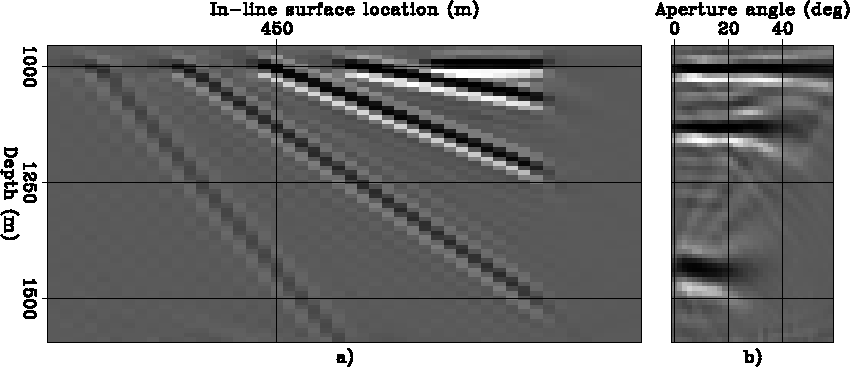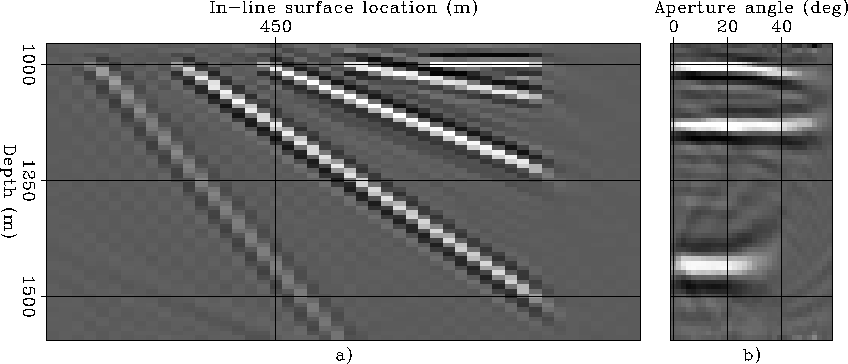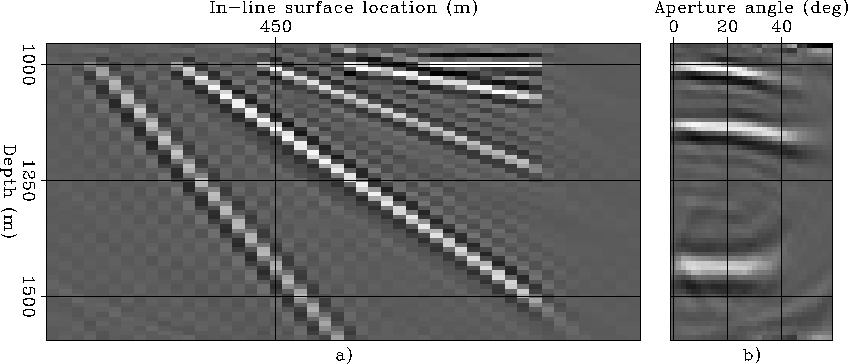|
stack-cig-azim0-data1
Figure 5 The reflection azimuth angle ( |  |
![[*]](http://sepwww.stanford.edu/latex2html/cross_ref_motif.gif) ,
, ![[*]](http://sepwww.stanford.edu/latex2html/cross_ref_motif.gif) and
and
![[*]](http://sepwww.stanford.edu/latex2html/cross_ref_motif.gif) show the reflections for three
different azimuths of the reflection.
2) for 3 different values of the reflection azimuth angle.
show the reflections for three
different azimuths of the reflection.
2) for 3 different values of the reflection azimuth angle.
|
stack-cig-azim0-data1
Figure 5 The reflection azimuth angle ( |  |
|
stack-cig-azim12-data1
Figure 6 The reflection azimuth angle ( |  |
|
stack-cig-azim18-data1
Figure 7 The reflection azimuth angle ( |  |
Figure ![[*]](http://sepwww.stanford.edu/latex2html/cross_ref_motif.gif) has been computed for a reflection
azimuth set to zero (
has been computed for a reflection
azimuth set to zero (![]() ). The best imaged reflectors are the least
dipping ones. Indeed, when the reflector is close from the horizontal,
the bending is not important and the rotation of the source ray with respect
to the receiver ray is negligeable.
The azimuth displayed in Figure
). The best imaged reflectors are the least
dipping ones. Indeed, when the reflector is close from the horizontal,
the bending is not important and the rotation of the source ray with respect
to the receiver ray is negligeable.
The azimuth displayed in Figure ![[*]](http://sepwww.stanford.edu/latex2html/cross_ref_motif.gif) is
is
![]() . It means that when the rotation of the rays is
. It means that when the rotation of the rays is ![]() at the
reflection point then the reflector is well imaged. For such amount of
rotation, the reflector must have a reasonable dip. That is what
we observe in Figure
at the
reflection point then the reflector is well imaged. For such amount of
rotation, the reflector must have a reasonable dip. That is what
we observe in Figure ![[*]](http://sepwww.stanford.edu/latex2html/cross_ref_motif.gif) : the plane with a
: the plane with a
![]() dip displays a wide and sharp angle gather.
In Figure
dip displays a wide and sharp angle gather.
In Figure ![[*]](http://sepwww.stanford.edu/latex2html/cross_ref_motif.gif) , the azimuth selected is even
bigger. It is for this amount of rotation that the angle gather for the
, the azimuth selected is even
bigger. It is for this amount of rotation that the angle gather for the
![]() dipping reflector is the best defined.
dipping reflector is the best defined.